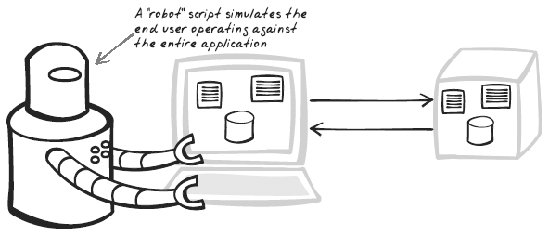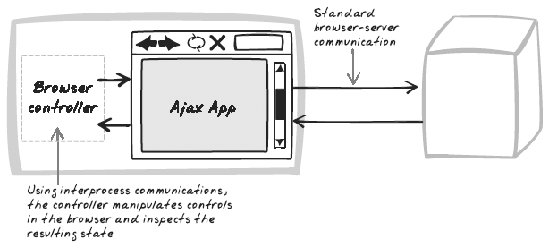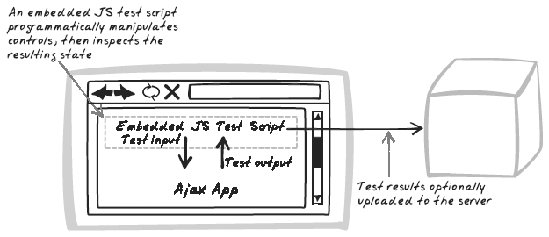Section 19.4. System Test
19.4. System TestAutomated, FunctionalTest, JavaScript, PerformanceTest, Regression, Robot, UnitTest, TDD, Test Figure 19-5. System Test 19.4.1. Developer StoryDevi has completed the first cut of a new Ajax App and wants to build an automated test of the whole thing. With the help of a testing application, she records a typical usage so it can be played back later. The software takes note of the final state, which will be used for verification during automated playback. 19.4.2. ProblemHow can you test an entire Ajax App? 19.4.3. SolutionBuild automated tests to simulate user behavior and verify the results. A System Test exercises a complete system in much the same way as a user would. The most common category of system test is a functional testverifying the functionalitybut system testing also encompass qualities such as performance and robustness. While they are often conducted manually, with users clicking and mousing around, it's highly preferable to automate as much as possible in order to promote continuous integration. Automated system tests remain somewhat difficult, but tools are improving. They can be broadly categorized as follows:
Figure 19-8. Browser Simulation The first two approaches involve a real browser, which is a more realistic test, but it does imply that the test must run on a machine capable of launching the browser, or of somehow controlling it remotely. System Tests require not just automation of user behavior, but also automation of result verification. As with other tests, results can be verified with a combination of assertions against the DOM and against server-side state. 19.4.4. Tool Support19.4.4.1. GhostTrainScriptaculous's GhostTrain (http://wiki.script.aculo.us/scriptaculous/show/GhostTrain) is an Embedded Browser Script with recording capability. When you start the recording mode, a Scriptaculous test case begins to fill up inside the div. Each mouse and key action becomes a new line of the test case. Later on, you can add your own assertions about the application state. GhostTrain is a very promising work in progress. 19.4.4.2. WatirWatir (http://wtr.rubyforge.org) follows the Browser Controller approach, enabling a Ruby programmer to script browser behavior and interrogate the DOM at any stage. You can easily integrate Watir commands into a standard test casefor example: ie = Watir::IE.start("http://ajaxpatterns.org") ie.button(:name, "Search").click Watir is IE-specific right now. 19.4.4.3. SeleniumSelenium (http://selenium.thoughtworks.com/) is an open source tool by Thoughtworks developers, an Embedded Browser Script framework that works in IE, Mozilla, Firefox, and Safari. A JavaScript Selenium component is embedded inside the browser application under test, and it communicates with a server-side component. Interesting, there's flexibility on the location of the server-side component. It can be placed in the web server, to provide a quick summary in the web page being developed. Alternatively, it can be run as a separate server, where the server controls the browser (like a Browser Controller would), and the embedded browser component merely transmits server commands to the application. 19.4.4.4. HTTPUnitHTTPUnit (http://httpunit.sourceforge.net/index.html) is an open source Java testing framework, built on JUnit, and specifically designed for testing web apps. It works as a Browser Simulator, converting an HTML page into a Java HTMLPage object that wraps a Java DOM model of the original HTML. HTTPUnit simulates JavaScript by delegating to the Rhino JavaScript engine, although support is incomplete. 19.4.4.5. DojoToolkitDojo Toolkit (http://dojotoolkit.org/docs/compressor_system.html) is a Java-based Browser Simulator that uses Rhino to let you run tests from an Ant task. Given the project's momentum and focus on Ajax, it's likely to evolve into a very solid product. 19.4.5. Code Example: Using Scriptaculous GhostTrainThe Ajax Patterns Reader (http://ajaxify.com/run/reader/logging/realService/ghost/) is refactored here to include Scriptaculous's GhostTrain (http://wiki.script.aculo.us/scriptaculous/show/GhostTrain), discussed earlier. You can hit Escape anywhere in the document to open it up, and then use the buttons to record a test case, which can then be played back (Figure 19-9). Figure 19-9. GhostTrain To hook up GhostTrain, the Scriptaculous library files must be included (quite a lot to download, but keep in mind they don't need to be included in production): <script type="text/javascript" src="/books/2/755/1/html/2//run/Lib/js/sc/prototype.js"></script> <script type="text/javascript" src="/books/2/755/1/html/2//run/Lib/js/sc/controls.js"></script> <script type="text/javascript" src="/books/2/755/1/html/2//run/Lib/js/sc/effects.js"></script> <script type="text/javascript" src="/books/2/755/1/html/2/unittest.js"></script> <script type="text/javascript" src="/books/2/755/1/html/2/ghosttrain.js"></script> The only other requirement is to register the GhostTrain object as a keypress handler. The handler will take care of any other initialization: window.onload = function( ) { Event.observe(document, 'keypress', GhostTrain.intercept, true); ... } 19.4.6. Related Patterns19.4.6.1. Browser-Side TestSystem Test frameworks that work as Embedded Browser Scripts are a form of Browser-Side Tests (see earlier). 19.4.6.2. Simulation ServiceFor integration tests, you can configure the server to run against a Simulation Service (see earlier). That way, you'll have tight control over server behavior, ensuring the final state is deterministic. 19.4.7. Want to Know More?
|
- Structures, Processes and Relational Mechanisms for IT Governance
- Integration Strategies and Tactics for Information Technology Governance
- Linking the IT Balanced Scorecard to the Business Objectives at a Major Canadian Financial Group
- A View on Knowledge Management: Utilizing a Balanced Scorecard Methodology for Analyzing Knowledge Metrics
- Governance Structures for IT in the Health Care Industry

